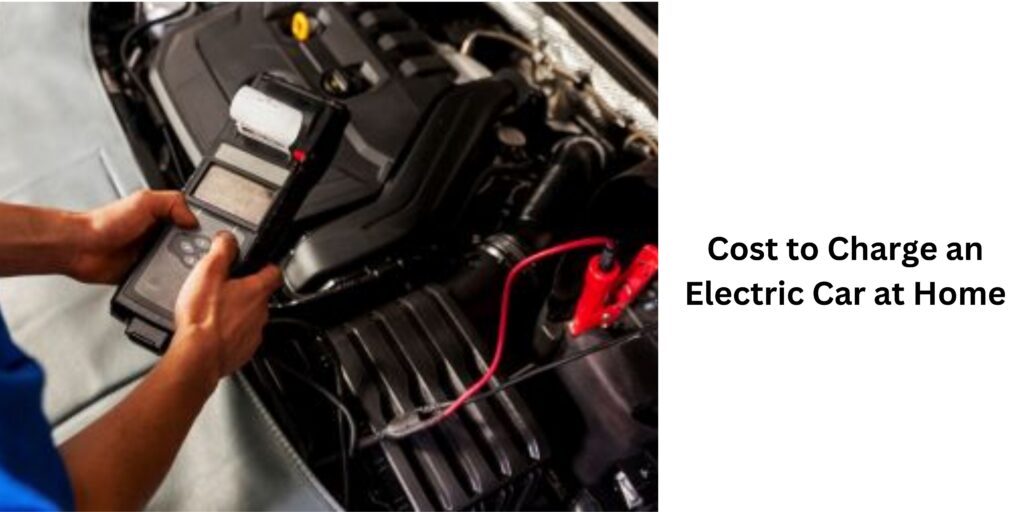Introduction
Electric vehicles (EVs) have transformed how we think about transportation. They provide a great option to gas-powered cars. They use cleaner energy and have lower running costs. However, understanding how much it costs to keep an EV charged is crucial. This article will explain everything—from the basic principles of how EVs work to the finer details of charging costs.
The guide is designed to help you make an informed decision if you’re considering purchasing an electric car. It covers the costs of charging at home, using public stations, and even how your driving habits affect your energy use. We’ll also compare EV charging costs with gasoline expenses, so you can see the overall benefits of going electric.

How Electric Cars Work
Before diving into the costs, it helps to understand the basics of how electric cars operate. Unlike traditional cars, EVs run on electricity stored in large batteries instead of gasoline. Here’s a simple breakdown:
- Battery Packs: These are the heart of an electric car. They store the energy needed to power the vehicle.
- Electric Motor: Instead of an engine, EVs have an electric motor that converts stored energy into motion.
- Charging System: Just like a smartphone, an electric car’s battery gets charged by connecting to a power source. This can be a standard household outlet or a specialized charger.
There are two main types of electric vehicles:
- Battery Electric Vehicles (BEVs): These run solely on electricity.
- **Plug-in Hybrid Electric Vehicles (PHEVs):** They mix a battery and a regular gasoline engine. This gives you the best of both worlds.
Understanding these basics will make it easier to grasp why charging costs can vary so much.
Why Charging Costs Matter
When considering an EV, you might be curious about the total cost of ownership.The upfront cost of an electric car can be more than a regular car. However, lower operating and maintenance costs often make up for it. Charging is a significant part of those operating costs.
Key points to consider:
- Operational Savings: EVs have fewer moving parts, which generally means lower maintenance expenses.
- Fuel Costs: Electricity is often cheaper than gasoline. This is one of the major attractions of owning an electric car.
- **Environmental Benefits:** Charging an EV cuts greenhouse gas emissions. This is even better if the electricity is from renewable sources.
Read more:
Knowing how much you’ll spend on charging can help you budget better and decide if an EV fits your lifestyle.
Types of Electric Car Charging
There are several ways to charge an electric car, and each method has its own cost structure. Let’s take a look at the main types:
Home Charging
Home charging is the most popular and often the most cost-effective option. You can plug your EV into a standard outlet or use a specialized charger for faster charging. The cost primarily depends on:
- Local Electricity Rates: Typically measured in cents per kilowatt-hour (kWh). The national average is around $0.13 per kWh, but this can vary by region.
- Battery Capacity: Larger batteries require more energy to charge, thus costing more.
Advantages:
- Convenience: Charge your car overnight while you sleep.
- Lower Cost: Generally cheaper than public charging, especially if you charge during off-peak hours.
Disadvantages:
- Speed: Standard outlets (Level 1 charging) can be slow, though upgrading to a Level 2 charger speeds things up.
Public Charging
Public charging stations are available in many cities, shopping centers, and along highways. These stations offer faster charging speeds compared to a standard home outlet.
Cost Factors:
- Pricing Models: Some stations charge by the minute, while others charge a flat rate or by the kWh used.
- Network Variations: Costs can differ greatly between networks. Some may offer discounted rates during off-peak hours.
Advantages:
- Speed: Often faster than home charging, especially if using DC fast chargers (Level 3).
- Convenience for Long Trips: Ideal when you’re on the go and need a quick top-up.
Disadvantages:
- Higher Costs: Generally, public charging is more expensive than charging at home.
- Availability: Depending on where you live, public chargers may not always be conveniently located.
Workplace Charging
Many employers now offer workplace charging as a perk for employees. This means you might be able to charge your EV while at work, often for free or at a very low cost.
Advantages:
- Cost Savings: Often provided as a free benefit.
- Convenience: Charges while you work, reducing the need for home charging.
Disadvantages:
- Limited Availability: Not all employers offer this, and it might not be available at all locations.
- Time Restrictions: You may have limited access depending on your work schedule.
Free Charging
In some urban areas or specific locations, free charging stations are becoming more common. Local governments or businesses might offer free charging to encourage the use of electric vehicles.
Advantages:
- Zero Cost: Free charging can significantly reduce your overall expenses.
- Encourages EV Adoption: Helps promote the use of electric vehicles in the community.
Disadvantages:
- Limited Locations: These stations are not yet widespread.
- Potential for Overuse: Free chargers might be busy or have usage limits.
Factors That Influence Charging Costs
Charging an electric car is not as simple as filling up a gas tank. Several factors can influence the cost of charging:
- Electricity Rates: The cost per kWh can vary based on your location, time of day, and utility provider. Many utilities offer time-of-use (TOU) rates, where electricity is cheaper during off-peak hours.
- Battery Size: Larger batteries store more energy and therefore cost more to charge fully. For example, a 100 kWh battery will cost significantly more to charge than a 40 kWh battery.
- Vehicle Efficiency: Some electric cars are more efficient than others. A car that travels further per kWh of energy will naturally cost less to drive in the long run.
- Charging Speed: Faster charging methods, such as DC fast charging, often come at a premium compared to slower methods like Level 1 or Level 2 charging.
- Charging Equipment: The type of charger you use—whether it’s a standard home outlet, a Level 2 charger, or a Level 3 fast charger—will affect the overall cost.
- Location: Charging at home is usually the cheapest, while public stations can be more expensive. However, some public or workplace stations offer lower rates or even free charging.
- Driving Habits: How you drive your car affects how often you need to charge itAggressive driving, speeding, and using air conditioning a lot can raise energy use. This can lead to higher charging costs.
Charging Equipment and Installation Costs
When it comes to home charging, the equipment you use matters. Let’s look at the three main types of chargers available for electric vehicles:
Level 1 Charging
- What It Is: Level 1 charging uses a standard household outlet (120V). It’s the slowest charging method but doesn’t require any extra equipment.
- Cost: Since it uses your home’s existing electrical system, there’s no additional cost for equipment. However, the charging speed is much slower, which may not be ideal for daily use if you drive long distances.
Level 2 Charging
- What It Is: Level 2 chargers use a 240V outlet, similar to what is used by large appliances like dryers. These chargers can charge your EV much faster than Level 1 chargers.
- **Cost:** The charger can cost a few hundred dollars. Professional installation may cost several hundred to over a thousand. dollars. However, the faster charging speed often makes this a worthwhile investment for daily drivers.
Level 3 Charging (DC Fast Charging)
- What It Is: Level 3 chargers, also known as DC fast chargers, provide rapid charging. They’re usually found at public stations rather than in homes.
- Cost: The equipment and installation are more expensive, and the per-charge cost is typically higher. These chargers are ideal for quick stops during long trips rather than everyday use.
Key Takeaway: If you primarily charge at home and don’t drive very long distances every day, Level 1 or Level 2 charging might be sufficient. If you often travel long distances or need a quick charge, public DC fast chargers can be very useful, albeit at a higher cost.
A Closer Look at Charging Costs
Charging costs can be broken down into two main parts: the cost of electricity and any fees associated with the charging method.
Electricity Cost Calculation
To find the cost of charging an electric car, multiply the energy needed (in kilowatt-hours) by your local electricity rate.For example:
- National Average: Let’s assume an average electricity rate of $0.13 per kWh.
- Battery Size: Consider a battery size of 54 kWh (like that of a Tesla Model 3 Standard Range Plus).
To fully charge this battery from 0% to 100%:
Cost = Battery Capacity × Electricity Rate = 54 kWh × $0.13/kWh = $7.02
So, a full charge would cost about $7.02 under these assumptions. Most drivers, however, do not charge from 0% every time. Partial charges will, therefore, cost less.
Other Costs
- Public Charging Fees: In addition to the basic electricity cost, public chargers may charge extra fees (per minute or per session).
- Service Fees: Some charging networks add a service fee to the energy cost.
- Installation Fees: For home charging, consider the cost of purchasing and installing a Level 2 charger if you choose to upgrade from a standard outlet.
Example: Charging a Tesla Model 3
Let’s take a closer look at an example calculation for a popular electric car, the Tesla Model 3 Standard Range Plus:
- Battery Capacity: 54 kWh
- Electricity Rate: Approximately $0.13 per kWh (this rate can vary by location)
- Full Charge Cost Calculation:54 kWh × $0.13/kWh = $7.02This means that if you charged your Model 3 from empty to full, you would spend about $7.02. In reality, you may not charge from 0% each time. For example, if you charge from 25% to 100%, you would only pay for about 75% of the battery’s capacity, which lowers the cost.
- Comparing with Public Charging: Public stations may have a different rate structure and additional fees, making a quick charge more expensive than charging at home.
This simple example shows that electric vehicle charging can be very affordable compared to fueling a gasoline car.
Comparing EV Charging Costs to Gasoline
One of the biggest advantages of electric cars is that charging them is generally cheaper than filling up a gas tank. Let’s compare the costs:
- **Electric Car Cost per Mile:** For the Tesla Model 3, which gets around 4 miles per kWh, the cost per mile can be calculated using an electricity rate of $0.13 per kWh. So, the cost per mile is about:Cost per Mile=$0.134 miles≈3.25 cents per mile\text{Cost per Mile} = \frac{\$0.13}{4 \, \text{miles}} \approx 3.25 \, \text{cents per mile}Cost per Mile=4miles$0.13≈3.25cents per mile
- Gasoline Car Cost per Mile: Consider a gasoline car that gets 25 miles per gallon with gasoline costing $3.00 per gallon. The cost per mile is:Cost per Mile=$3.0025 miles=12 cents per mile\text{Cost per Mile} = \frac{\$3.00}{25 \, \text{miles}} = 12 \, \text{cents per mile}Cost per Mile=25miles$3.00=12cents per mile
As you can see, even with rough estimates, charging an EV costs significantly less per mile than driving a gasoline car. Over time, these savings can add up, making electric vehicles a more economical choice in the long run.
Frequently Asked Questions (FAQs)
Q1: How much does it cost to charge an electric car at home?
The cost depends on your local electricity rate and your car’s battery capacity. On average, a full charge might cost between $3 and $7. Charging during off-peak hours can further reduce your bill.
Q2: What factors affect the cost of charging an electric car?
A: Key factors include the electricity rate, the size of your car’s battery, vehicle efficiency, charging speed, and whether you’re charging at home or using public stations.
Q3: How do public charging costs compare to home charging?
A: Public charging stations may charge by the minute, per session, or per kWh, and often include extra fees. Home
Q4: What is the installation cost for a home charging station?
A: Installing a Level 2 charger can range from a few hundred to over a thousand dollars, depending on the charger model and installation requirements. Many state and federal incentives may help offset these costs.
Q5: Is charging an electric car cheaper than fueling a gasoline car?
A: Yes. For example, an EV might cost around 3.25 cents per mile to charge compared to about 12 cents per mile for a gasoline car, based on typical consumption figures.
Environmental Impact of EV Charging
Electric vehicles don’t produce tailpipe emissions. However, it’s crucial to think about where the electricity for charging comes from. Here’s what you should know:
- Reduced Emissions: Electric cars produce zero emissions while driving.Even if the electricity comes from fossil fuels, EVs usually have lower overall emissions than gasoline cars.
- The Greener Grid: As more renewable energy sources like wind and solar come online, the electricity grid is becoming cleaner. This means that over time, charging an electric car will have an even smaller carbon footprint.
- Sustainability: Charging with renewable energy promotes a sustainable future. It also cuts down our reliance on fossil fuels.
Future Trends in EV Charging
The world of electric vehicles is evolving quickly. Here are some trends that could further reduce charging costs and improve convenience:
- **Improved Battery Technology:** New battery tech offers longer ranges and quicker charging. This makes EVs more attractive.
- More Charging Stations: The number of public charging stations is growing rapidly. This expansion will make it easier for EV owners to find convenient charging options.
- * **Smart Charging Solutions:** These clever charging systems adjust speeds and times automatically. **They take advantage of lower electricity rates, so you can save money. Incentives and Government Policies:** Many states and countries provide tax credits, rebates, and other incentives to encourage electric vehicle adoption.. Future policy changes may provide even more support for EV owners.
- Integration with Renewable Energy: Home charging systems integrated with solar panels or other renewable energy sources can further reduce charging costs and make EVs more sustainable.
The future of EV charging looks bright, with technology and policy trends working together to make electric vehicle ownership even more affordable and environmentally friendly.
Practical Tips to Save Money on Charging
Here are some straightforward tips to help you reduce your electric car charging costs:
- Charge at Home During Off-Peak Hours: Many utilities offer lower rates during the night or other off-peak times. Plan your charging sessions accordingly.
- Invest in a Level 2 Charger: Although there’s an upfront cost, a Level 2 charger can reduce your charging time and often save money in the long run.
- Take Advantage of Workplace Charging: If your employer offers free or discounted charging, make sure to use it.
- **Find Free Charging Stations:** Check local shops, malls, and public parking lots for free EV charging.
- Monitor Your Driving Habits: Drive efficiently to maximize your EV’s range. Smooth acceleration and moderate speeds can help conserve battery power.
- Regular Maintenance: Keeping your electric car in good condition can improve its efficiency, reducing overall energy consumption.
- Plan Long Trips Wisely: Use apps and maps to find the most cost-effective charging stations along your route.
By following these tips, you can enjoy the benefits of driving an electric car while keeping your charging costs as low as possible.
Conclusion
Electric cars have great benefits. They cut greenhouse gas emissions. Plus, they save you money on fuel and maintenance.. Understanding the cost to charge an electric car is a key part of making the switch from gasoline to electric. In this article, we explored:
- How electric cars work and why they’re different from conventional vehicles.
- Various charging options including home, public, workplace, and free charging.
- Factors that affect charging costs, such as local electricity rates, battery size, and charging speed.
- Detailed cost examples, like charging a Tesla Model 3, which help put numbers into perspective.
- Comparisons between EV charging and gasoline costs, showing that electric cars can be much cheaper per mile.
- Environmental benefits and how charging an EV can reduce your carbon footprint.
- Future trends and practical tips to save money on charging, ensuring you make the most of your investment.
While the upfront cost of an electric car may be higher, the long-term savings on fuel and maintenance can make it a wise choice. Also, the environmental benefits add to its appeal. As technology improves and charging stations grow, owning an EV will be more convenient and affordable.
By understanding these details and planning your charging habits, you can enjoy the benefits of electric vehicles. Whether you’re commuting, going on a road trip, or wanting to lower your environmental impact, knowing the real cost of charging an electric car helps you decide wisely.





